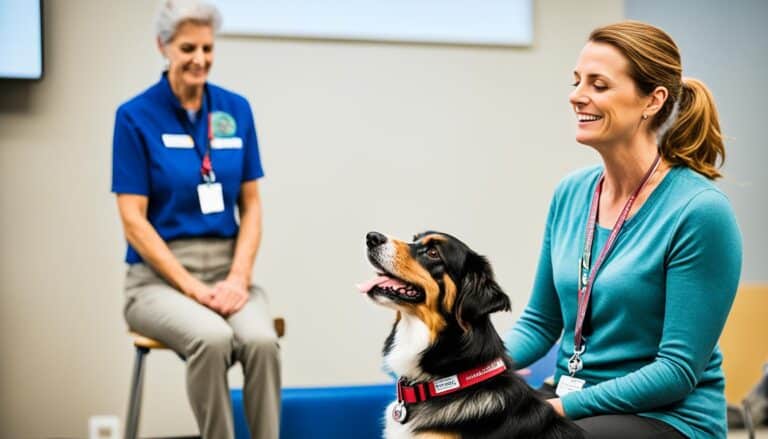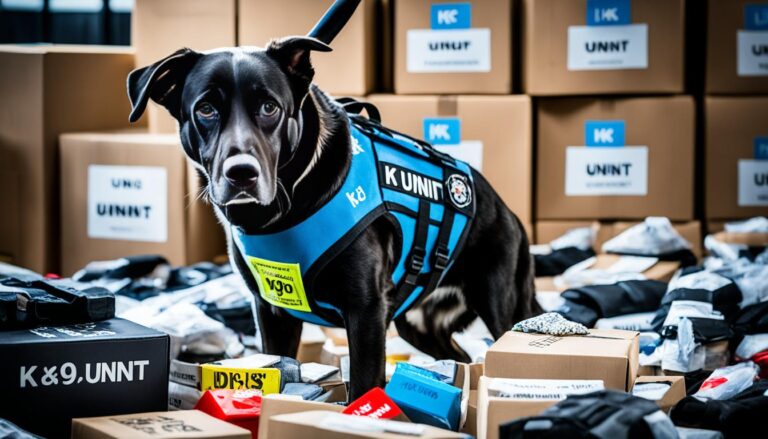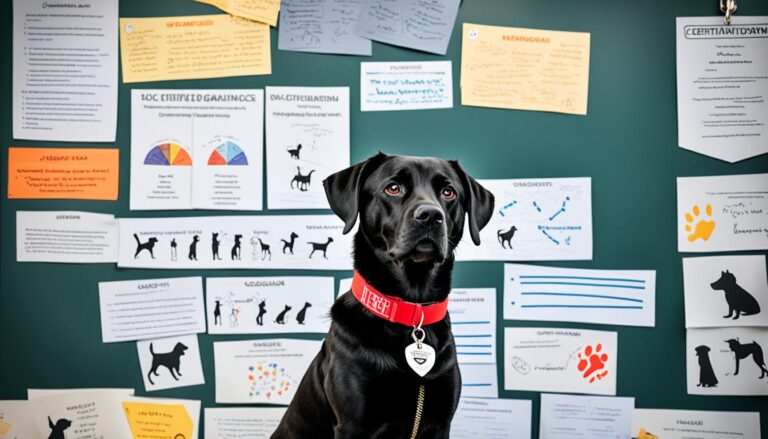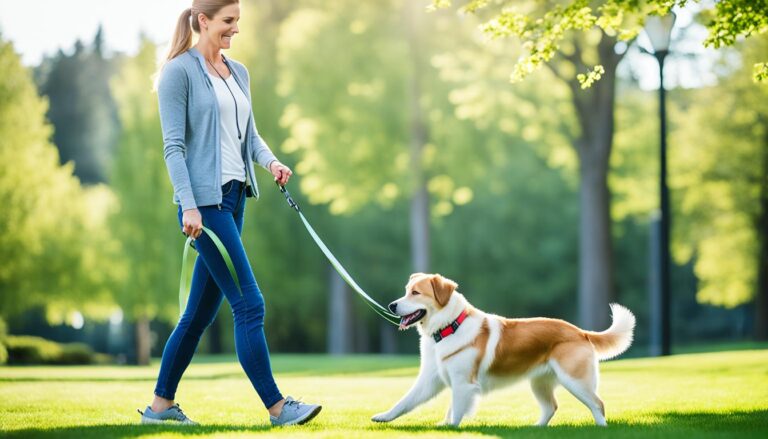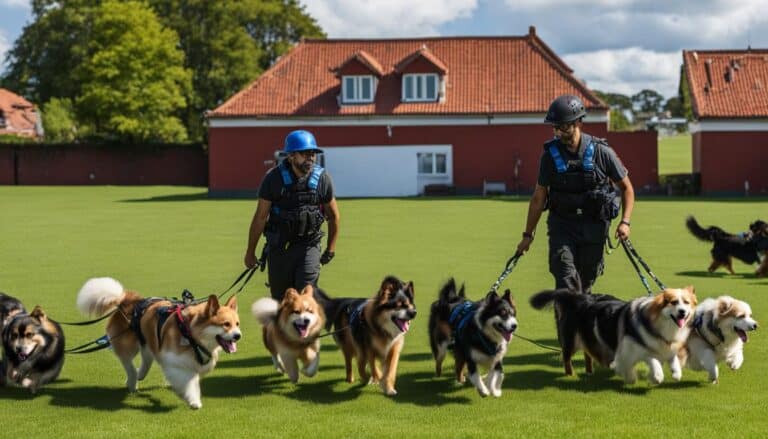What Is Agility Training for Dogs?
Have you ever watched a dog gracefully bounding through an obstacle course, their tail wagging with pure joy and enthusiasm? It’s a sight that never fails to bring a smile to your face. And perhaps it also sparks a desire in you to explore this exciting world of agility training with your own furry friend.
Agility training is more than just a sport for dogs. It’s a way to challenge their physical abilities, sharpen their mental acuity, and strengthen the bond between you and your canine companion. It’s a journey of growth, discovery, and shared moments of triumph.
Whether you have a rambunctious young pup bursting with energy or a wise, old soul who still loves to learn new tricks, agility training is a fulfilling adventure that can be enjoyed by dogs of all ages and breeds. From the smallest Chihuahuas to the biggest Great Danes, agility provides a platform for canines to showcase their talents and athleticism.
So, what exactly is agility training for dogs? In its simplest form, agility involves directing your dog through a pre-set obstacle course within a certain time limit. The course is filled with thrilling challenges like tunnels, weave poles, tire jumps, seesaws, and pause tables. You and your dog will work together as a team, relying on clear communication and trust to navigate the course successfully.
In this article, we will delve deeper into the world of agility training, exploring the basics, understanding if it’s the right fit for you and your dog, finding the right classes or groups, and even considering the possibility of competing. Are you ready to embark on this exciting journey with your four-legged friend?
Understanding the Basics of Dog Agility
Dog agility is an exciting sport that involves guiding your furry friend through a pre-set obstacle course within a specific time limit. The course is designed with 14-20 obstacles that challenge your dog’s agility and skills. These obstacles include tunnels, weave poles, tire jumps, seesaws, and pause tables.
Your dog relies on your cues and body language to navigate the course successfully. By providing clear instructions and using proper handling techniques, you can guide your dog through the challenges with speed and accuracy. Agility is an inclusive sport that welcomes dogs of all breeds and sizes, making it a fun activity for everyone.
Let’s take a closer look at some of the key obstacles that you and your dog will encounter during agility training:
- Tunnels: Dogs will need to navigate through tunnels, which test their ability to follow commands and maneuver in confined spaces.
- Weave Poles: This obstacle consists of a series of upright poles that your dog must weave in and out of as quickly as possible. It requires excellent coordination and focus.
- Tire Jumps: Dogs must jump through a suspended tire without touching it. It tests their jumping ability and accuracy.
- Seesaws: Dogs walk onto a seesaw-like platform and must maintain balance as it tilts. It assesses their ability to adapt to moving obstacles.
- Pause Tables: Dogs must stop and stay on a designated table for a specified period. It helps them practice self-control and focus.
By mastering these obstacles, your dog will become more agile, confident, and mentally stimulated. With practice and training, you and your dog will form a strong bond and achieve great success in dog agility.
Is Agility Right for Your Dog and You?
Before starting agility training, it’s important to assess your dog’s temperament. Agility training is best suited for dogs who are highly energetic, enjoy running, and respond well to instruction. If your dog is always ready to play and has boundless energy, agility training could be a perfect fit.
Considering your dog’s temperament is crucial because agility requires a certain level of focus and obedience. Energetic dogs that love to run and play will thrive in this dynamic and stimulating sport. They need to be able to stay focused on the course and follow your instructions.
Your dog’s ability to get along well with other dogs is also important. Agility training involves interacting with other dogs, and it’s essential for your dog to be comfortable in a group setting. This ensures a safe and enjoyable experience for everyone involved.
But it’s not just about your dog’s temperament. Your own involvement is crucial as well. Agility training is a team effort, so you need to be an active participant in the training process. You will be responsible for directing your dog through the course and providing clear cues. Your enthusiasm, patience, and consistency will contribute to the success of your dog’s agility training.
Agility training offers numerous benefits for both you and your dog. Besides keeping your dog physically fit, it provides mental stimulation and strengthens the bond between you. It’s a rewarding and fulfilling activity that allows you to spend quality time with your furry friend. So, if you have an energetic dog with a great temperament and are ready to embark on an exciting journey together, agility training may be just what you both need.
Benefits of Agility Training:
- Keeps your dog physically fit
- Provides mental stimulation
- Strengthens the bond between you and your dog
- Allows you to spend quality time together
Taking a Class for Agility Training
If you’re ready to dive into the exciting world of agility training, enrolling in agility training classes is a great way to start. At an AKC club, you can find beginner courses specifically designed to introduce you and your dog to the fundamentals of agility training. These classes provide a structured learning environment where both you and your furry friend can thrive.
During agility training classes, you will learn the basics of agility, including how to navigate the various obstacles and communicate effectively with your dog. The instructors at the AKC club will guide you through each step of the process, ensuring that you and your dog understand the techniques and strategies necessary for a successful agility performance.
Typically, these classes meet once a week, allowing you and your dog to build consistency and rhythm in your training routine. The group setting also provides an opportunity to connect with other dog owners who share your passion for agility. You can exchange tips and ideas, creating a supportive community that motivates and inspires each other.
By enrolling in these agility training classes, you’ll not only be learning agility skills but also enhancing the bond between you and your dog. It’s a wonderful opportunity to strengthen your relationship through shared experiences and mutual learning.
Why Take Agility Training Classes?
- Structured learning environment: Agility training classes provide a structured environment where you and your dog can learn and grow together.
- Effective communication: Instructors will teach you how to effectively communicate with your dog, using voice commands and body language.
- Learning the basics: Beginner courses focus on teaching you and your dog the fundamentals of agility, from obstacle navigation to course strategies.
- Community support: Enrolling in agility classes allows you to connect with other agility enthusiasts, creating a supportive community that can offer guidance and motivation.
- Bonding with your dog: The training process fosters a stronger bond between you and your dog as you work together to overcome challenges and achieve goals.
Practicing Agility at Home
Now that you’ve learned the basics of dog agility in class, it’s time to reinforce those skills at home. Practicing agility at home is not only convenient but also essential for your dog’s ongoing training and progress. By dedicating just 15-20 minutes a day to at-home training sessions, you can help your dog become more comfortable with the obstacles and continue to develop their agility skills.
To create your own agility course at home, you’ll need some agility equipment. You can purchase agility equipment online or opt for a more budget-friendly approach by building your own DIY agility equipment. One of the simplest and versatile DIY options is using PVC pipes to create obstacles like tunnels and weave poles.

This image showcases a dog confidently tackling a homemade agility course. The inclusion of this image helps to visually demonstrate the concept of practicing agility at home, reinforcing the importance of at-home training.
During your at-home training sessions, focus on practicing the moves and techniques learned in class. Start with basic exercises and gradually increase the difficulty level as your dog progresses. Be mindful of creating a safe training environment, ensuring that the space is free of hazards and obstacles that may cause injuries to your dog.
An additional benefit of practicing agility at home is the flexibility it provides. You can train your dog at any time that suits your schedule, making it easier to fit agility training into your daily routine. This regular practice will not only improve your dog’s agility skills but also strengthen the bond between you and your furry companion.
Remember, consistency and positive reinforcement are key to successful at-home training. Encourage and reward your dog for their efforts and progress. With dedication and patience, your dog will become more confident and skilled in navigating the agility course.
Considering Competing in Agility
Agility training can be so thrilling and fulfilling that you may want to take your skills to the next level and compete with your dog. Competing in agility allows you to showcase the hard work you and your dog have put into training and provides an opportunity to challenge yourselves in a competitive environment.
If you’re ready to put your dog’s skills to the test, the AKC Agility Course Test (ACT) is a great starting point. The ACT evaluates your dog’s ability to navigate through an agility course and complete the required obstacles. It’s a wonderful way to gauge your dog’s progress and readiness for formal competition.
When you’re ready to compete, there are three types of agility trials to consider:
- All-breed agility trials: These trials are open to all breeds and mixed breeds, allowing you to compete against a diverse range of canine competitors.
- Specialty trials for specific breeds: These trials cater specifically to certain breeds, allowing you to compete against dogs with similar characteristics and abilities.
- Group trials for specific breed groups: These trials are organized based on breed groups, such as working dogs or small breeds, creating a level playing field for competitors.
Before entering a competition, it’s important to ensure that your dog is eligible to compete. Each competition may have specific age and registration requirements, which you must meet to ensure a fair and inclusive playing field for all competitors.
Additionally, it’s crucial to familiarize yourself with the regulations and rules for agility trials. These regulations cover various aspects, such as scoring, time limits, and allowable faults. By understanding and adhering to these regulations, you can ensure a fair and enjoyable competition experience for both you and your dog.
Competing in agility can be an exciting and rewarding experience. It allows you to showcase your dog’s skills, compete against fellow enthusiasts, and further strengthen the bond between you and your furry companion. So, if you’re up for the challenge, start exploring agility competitions and take your agility journey to new heights!
Benefits of Agility Training
Agility training is not just a fun dog sport—it offers numerous benefits for both you and your furry friend. When your dog participates in agility training, they tap into their natural hunting instincts, engage in good exercise, and experience mental stimulation through problem-solving.
One of the key advantages of agility training is that it provides an opportunity for your dog to channel their natural instincts. The sport allows them to use their senses, enhance their focus, and satisfy their desire to explore their surroundings. By navigating the obstacle course, your dog gets to exercise their hunting skills in a controlled and enjoyable environment.
Not only does agility training satisfy your dog’s natural instincts, but it also provides them with a great physical workout. Running, jumping, and maneuvering through the obstacles helps keep your dog fit, preventing obesity and promoting overall health. Agility is an excellent form of exercise that targets different muscle groups and improves cardiovascular endurance.

The mental stimulation offered by agility training is another significant advantage. As your dog faces various obstacles, they must think quickly and problem-solve to successfully complete the course. This mental challenge keeps their brain sharp and engaged, which is beneficial for dogs of all ages, especially for senior dogs who may need additional mental stimulation.
But agility training doesn’t only benefit your dog—it also strengthens the bond between you and your furry companion. During agility training, you and your dog work together as a team, relying on clear communication and trust. This collaborative effort deepens your connection and enhances your relationship.
The sport provides a shared activity that both you and your dog can enjoy. Whether you’re participating in training sessions or competing in agility trials, the journey is filled with fun and excitement. The sense of accomplishment you feel when your dog successfully completes each obstacle is incredibly rewarding and creates lasting memories.
In summary, agility training brings a range of benefits. It lets your dog tap into their natural instincts, offers good exercise, stimulates their mind, and fosters a strong bond between you and your furry friend. So, engage in agility training and experience the joy of watching your dog shine!
Things to Consider Before Starting Agility Training
Before embarking on agility training with your dog, there are several important factors to consider to ensure a successful and enjoyable experience for both of you.
Physical Fitness
Agility training requires your dog to run, jump, and maneuver through various obstacles. Therefore, it is essential that both you and your dog are physically fit. Make sure your dog has sound joints and a healthy heart to handle the physical demands of the sport.
Dog’s Temperament
Considering your dog’s temperament is crucial before starting agility training. This sport is best suited for highly energetic dogs who enjoy running and can respond well to instruction. Additionally, your dog should be comfortable around other dogs, as agility training often involves working in close proximity to other canine participants.
Motivational Incentives
Understanding what motivates your dog is key to keeping them engaged during agility training sessions. Some dogs may respond well to treats as rewards, while others may prefer verbal praise or playtime with their favorite toy. Discovering what drives your dog will help you create a positive and motivating training environment.
Physical Activity Considerations
It’s important to consider the level of physical activity your dog is currently accustomed to before starting agility training. If your dog has been relatively sedentary, it’s advisable to gradually increase their exercise levels and stamina to prevent injuries. Speak with your veterinarian to ensure your dog is ready for the physical demands of agility training.
Getting Started with Agility Training
Ready to embark on an exciting journey of agility training with your dog? It’s time to take the first step towards creating an agile and active canine companion. Whether you’re looking to engage in this fun sport as a hobby or eventually compete in agility trials, getting started is easier than you may think.
Finding Local Agility Groups
Connecting with local agility groups is a great way to immerse yourself in the world of agility training. These groups often organize training sessions, workshops, and social events where you can meet fellow agility enthusiasts, exchange training tips, and learn from experienced handlers. To find local agility groups in your area, try searching online platforms or reaching out to your local dog training clubs.
Creating a Homemade Agility Course
No access to a dedicated agility training facility? No problem! You can create a homemade agility course right in your backyard or local park. By using simple and affordable materials, such as planks, collapsible tunnels, or hanging tires, you can mimic the obstacles found in professional agility courses. The key is to ensure that the obstacles are safe and sturdy for your dog’s enjoyment and progress.
Finding a Group or Instructor
If you decide to take your agility training journey to the next level and pursue it more seriously, finding a group or private instructor can provide valuable guidance and support. A skilled instructor can teach you proper handling techniques, introduce you to advanced agility maneuvers, and help you navigate the rules and regulations of agility trials. They can also assess your dog’s progress and provide personalized training plans to improve performance.
Remember, agility training is not only a physical challenge for your dog but also a mental one. It requires focus, coordination, and trust between you and your furry friend. So, take a leap, seek guidance, and start this incredible adventure filled with excitement, bonding, and countless joyful moments with your agile athlete.
Agility Competitions and Levels of Difficulty
Agility competitions are the ultimate test of your dog’s skills and your teamwork. These exciting events require dogs to navigate a series of obstacles, showcasing their speed and accuracy. The courses are carefully designed to challenge both the handler and the dog, with various elements that test their agility and problem-solving abilities.
Fault scoring is an important component of agility competitions. Dogs may incur faults for dropping a bar, refusing an obstacle, or missing a contact zone. Faults can affect the final score and determine the ranking of participants. The scoring system ensures fairness and accuracy in evaluating each team’s performance.
Agility trial courses offer a wide variety of challenges, making each competition unique. Course variations include different sequences of obstacles, which require dogs to adapt and respond quickly to the handler’s instructions. These variations keep the competitions fresh and engaging for participants and spectators alike.
Agility competitions feature different levels of difficulty to accommodate dogs at various skill levels. Dogs can start competing at a certain age and progress through different levels as they gain experience and successfully complete lower level courses. This allows handlers and dogs to continuously challenge themselves and strive for improvement.
- Novice Level: This is the entry-level for agility competitions, designed for dogs and handlers who are new to the sport. The courses are relatively straightforward, focusing on building the foundation skills necessary for higher levels.
- Open Level: In the open level, the courses become more complex and demanding. Dogs and handlers must demonstrate a higher level of proficiency, combining speed, accuracy, and teamwork to conquer the challenges.
- Excellent Level: The excellent level is reserved for the most skilled agility teams. The courses are designed to test the limits of the dog and handler’s abilities, requiring precise execution, fast thinking, and flawless teamwork.
- Masters Level: The masters level represents the pinnacle of agility competition. This level is for the most accomplished and experienced teams, with courses that push the boundaries of agility skills. Only the best of the best can compete at this level.
Agility competitions offer a thrilling experience for both dogs and handlers. They provide an opportunity to showcase your training accomplishments and bond with your canine companion. Whether you’re starting out in the novice level or aiming for the prestigious masters level, agility competitions are a great way to challenge yourself and celebrate the incredible abilities of your four-legged partner.
The “One Mind” Connection in Agility Training
The best agility performances are a result of the seamless cooperation between the handler and the dog. To achieve this level of synchronization, the handler relies on their body language to direct the dog along the correct running lines. The OneMind Dogs method is a popular approach that emphasizes the essential elements of handler movement, position, eyes, chest, feet, arms, and vocal commands to effectively communicate with the dog. This method prioritizes clear and consistent cues from the handler, ensuring a strong connection and understanding between the handler and the dog.
During agility training and competitions, the communication between the handler and the dog is vital for a successful performance. The handler’s body language conveys important information to the dog, guiding them through the agility course. By fine-tuning their body movements, the handler can communicate turns, speed changes, and obstacle approaches to the dog. This level of cooperation establishes a state of “One Mind” between the handler and the dog, where they act as a unified team.
The Importance of Handler’s Body Language
The handler’s body language plays a crucial role in agility training. By using the right positioning and cues, the handler can convey directions and intentions to the dog efficiently. Here are some key aspects of the handler’s body language:
- Movement: Handlers should make deliberate and purposeful movements to signal the dog where to go. Quick, sharp movements can indicate turns, while smooth, flowing motions can encourage speed and commitment.
- Position: The handler’s position in relation to the dog and the obstacles can guide the dog’s path. Strategic positioning can help the dog take the most efficient and direct route to complete the course.
- Eyes: The handler’s gaze can direct the dog’s attention to specific obstacles or indicate upcoming cues. Eye contact can guide the dog’s focus and help them anticipate the next move.
- Chest: Open and facing the desired direction can signal the dog to continue forward. Closed or turned chests can indicate a turn or change in direction.
- Feet: The handler’s foot placement provides valuable information to the dog. Pointing in the direction or stepping towards an obstacle can encourage the dog’s movement towards it.
- Arms: Raised arms can signal the dog to jump, while extended arms can guide the dog towards a specific obstacle or indicate a turning point.
- Vocal Commands: Clear and consistent vocal cues help reinforce the handler’s body language and provide additional guidance to the dog.
By mastering these elements of the handler’s body language, handlers can effectively communicate with their dogs during agility training. The “One Mind” connection created through this level of cooperation enhances the dog’s understanding of the course and enables them to perform at their best.
Have Fun and Enjoy Agility Training
Above all, agility training should be a fun and enjoyable activity for both you and your dog. Whether you choose to compete or simply engage in agility as a shared hobby, the key is to have fun and strengthen the bond between you and your furry companion.
Agility training provides a unique opportunity for you and your dog to have fun together. As you navigate the obstacle course, you’ll both experience a sense of excitement and accomplishment. Watching your dog’s agility skills improve over time can be incredibly rewarding, and the joy they express when tackling obstacles fills the training sessions with positive energy.
Not only does agility training provide physical exercise for your dog, but it also offers mental stimulation. The problem-solving aspect of agility keeps your dog engaged and mentally sharp. Additionally, the shared activity promotes a deeper understanding of each other’s strengths and weaknesses, fostering a stronger connection between you and your canine companion.

